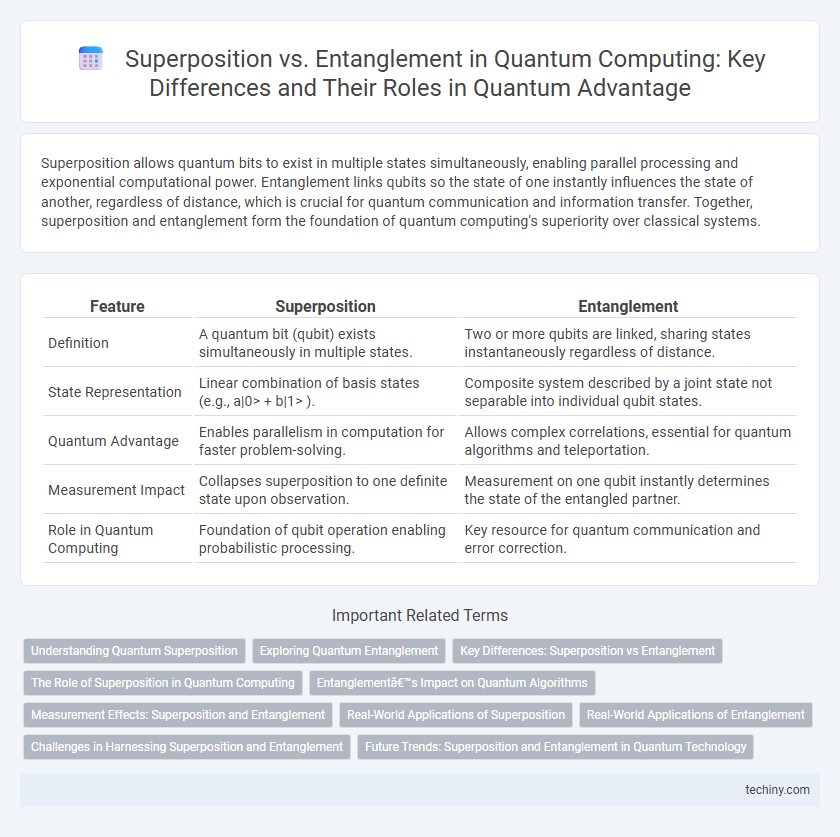Superposition allows quantum bits to exist in multiple states simultaneously, enabling parallel processing and exponential computational power. Entanglement links qubits so the state of one instantly influences the state of another, regardless of distance, which is crucial for quantum communication and information transfer. Together, superposition and entanglement form the foundation of quantum computing's superiority over classical systems.
Table of Comparison
| Feature | Superposition | Entanglement |
|---|---|---|
| Definition | A quantum bit (qubit) exists simultaneously in multiple states. | Two or more qubits are linked, sharing states instantaneously regardless of distance. |
| State Representation | Linear combination of basis states (e.g., a|0> + b|1> ). | Composite system described by a joint state not separable into individual qubit states. |
| Quantum Advantage | Enables parallelism in computation for faster problem-solving. | Allows complex correlations, essential for quantum algorithms and teleportation. |
| Measurement Impact | Collapses superposition to one definite state upon observation. | Measurement on one qubit instantly determines the state of the entangled partner. |
| Role in Quantum Computing | Foundation of qubit operation enabling probabilistic processing. | Key resource for quantum communication and error correction. |
Understanding Quantum Superposition
Quantum superposition enables a quantum bit (qubit) to exist simultaneously in multiple states, unlike classical bits restricted to 0 or 1. This principle underpins quantum parallelism, allowing quantum computers to process complex computations more efficiently. Understanding superposition is fundamental to harnessing quantum algorithms and optimizing quantum circuit design.
Exploring Quantum Entanglement
Quantum entanglement is a fundamental phenomenon where two or more qubits become interconnected, such that the state of one instantly influences the state of the other, regardless of the distance between them. This property enables powerful applications in quantum computing, including quantum teleportation, superdense coding, and enhanced computational speed for complex problems. Unlike superposition, which allows qubits to exist in multiple states simultaneously, entanglement creates a non-local correlation essential for quantum algorithms and quantum cryptography.
Key Differences: Superposition vs Entanglement
Superposition allows a quantum bit (qubit) to exist simultaneously in multiple states, representing both 0 and 1 until measurement collapses it to a single state. Entanglement occurs when qubits become interconnected such that the state of one qubit instantaneously influences the state of another, regardless of distance. While superposition pertains to the state of an individual qubit, entanglement describes the non-classical correlation between two or more qubits.
The Role of Superposition in Quantum Computing
Superposition enables quantum bits (qubits) to exist in multiple states simultaneously, exponentially increasing computational power compared to classical bits. This parallelism allows quantum computers to solve complex problems, such as factoring large numbers and simulating molecular structures, more efficiently. The coherent manipulation of superposed qubits is fundamental to quantum algorithms like Grover's and Shor's, driving advances in cryptography and optimization.
Entanglement’s Impact on Quantum Algorithms
Entanglement enables qubits to exist in correlated states, exponentially expanding computational power beyond classical systems. Quantum algorithms like Shor's and Grover's leverage entanglement to perform complex calculations with unprecedented speed and efficiency. This phenomenon underpins quantum parallelism, drastically improving problem-solving capabilities in cryptography and optimization tasks.
Measurement Effects: Superposition and Entanglement
Superposition allows qubits to exist in multiple states simultaneously, collapsing into a single state upon measurement, which directly affects the system's probabilistic outcomes. Entanglement creates correlations between qubits such that the measurement of one instantly determines the state of its entangled partner, regardless of distance. Measurement in entangled systems disrupts the shared quantum state, influencing both local and non-local properties critical for quantum algorithms and communication protocols.
Real-World Applications of Superposition
Superposition enables quantum computers to process multiple possibilities simultaneously, drastically enhancing computational speed for complex problems like cryptography and optimization. This principle is foundational in algorithms such as Shor's and Grover's, allowing unprecedented efficiency in factoring large numbers and searching unsorted databases. Real-world applications of superposition extend to drug discovery, material science, and financial modeling by simulating molecular interactions and market behaviors with high precision.
Real-World Applications of Entanglement
Quantum entanglement enables secure communication through quantum key distribution in cryptography, offering practically unbreakable encryption methods. Entangled particles form the basis of quantum networks, allowing instantaneous state transfer that enhances distributed quantum computing performance. These real-world applications demonstrate entanglement's critical role in advancing technologies like quantum sensing and high-precision measurements beyond classical limits.
Challenges in Harnessing Superposition and Entanglement
Harnessing superposition and entanglement in quantum computing faces significant challenges due to quantum decoherence and error rates that disrupt fragile quantum states. Maintaining coherence in qubits requires advanced error correction methods and isolation techniques to prevent environmental interference. Scalability remains a critical hurdle as entangled qubits increase complexity, demanding precise control and synchronization for reliable quantum operations.
Future Trends: Superposition and Entanglement in Quantum Technology
Future trends in quantum technology leverage superposition to enhance computational parallelism, enabling more efficient problem-solving across complex systems. Entanglement continues to be pivotal for quantum communication protocols and error correction, boosting data security and coherence in quantum networks. Advances in integrating superposition and entanglement are expected to drive breakthroughs in quantum algorithms and scalable quantum hardware development.
Superposition vs Entanglement Infographic

 techiny.com
techiny.com